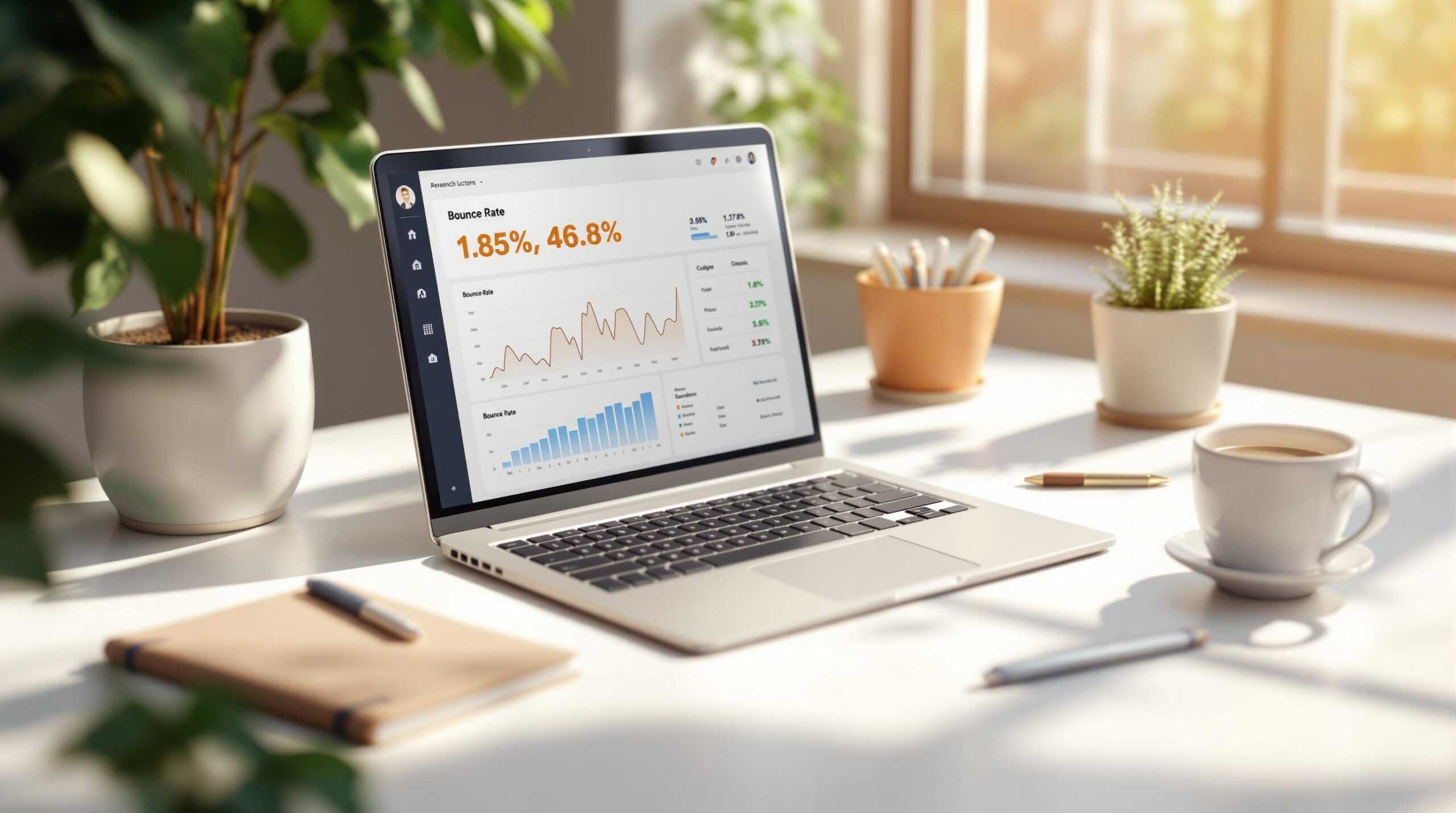Bounce rate is the percentage of visitors who leave your website after viewing just one page. A high bounce rate can hurt your SEO rankings because it signals poor user engagement or irrelevant content. Here’s why it matters and how to fix it:
- Why It Matters: Search engines like Google use bounce rate as a signal for content relevance, user experience, and page quality.
- Common Issues: Slow page speed, misleading content, poor design, or lack of mobile optimization can increase bounce rates.
- How to Fix It:
- Improve page load times (e.g., compress images, use a CDN).
- Align content with search intent through keyword research.
- Optimize site design for mobile and desktop users.
Key Tip: Use tools like Google Analytics to track bounce rates, identify problem areas, and make data-driven improvements. Lowering your bounce rate can lead to higher rankings, longer sessions, and more engaged visitors.
How to Reduce Bounce Rate 6 Simple Proven Methods
How Bounce Rate Affects SEO
User Signals and Rankings
Search engines, including Google, use user behavior to gauge how well a page meets visitors’ expectations. If users leave a page quickly without interacting, it may indicate issues with the content. Some key factors search engines consider are:
- Time on Site: Short visits suggest low interest or engagement.
- Page Views: Single-page visits often mean users didn’t explore further.
- Engagement Metrics: Minimal clicks or scrolling can point to a poor user experience.
According to SearchX, high bounce rates often align with drops in rankings. On the other hand, pages that keep users engaged tend to hold or improve their positions. By analyzing these patterns, you can pinpoint areas that need immediate improvement.
Common Bounce Rate Issues
Several factors can lead to high bounce rates, and addressing them can improve SEO performance. Here’s a breakdown:
| Issue Type | Impact on SEO | Common Causes |
|---|---|---|
| Page Speed | Slow-loading pages often lead to quick exits | Large image files, unoptimized code, slow servers |
| Content Mismatch | Irrelevant or misleading content can push users away | Misleading meta descriptions, poor keyword targeting |
| Design Problems | Poor design can frustrate users and cause them to leave | Lack of mobile optimization, confusing navigation, intrusive pop-ups |
To address these issues, consider the following steps:
- Regularly check page load times with tools like Google PageSpeed Insights.
- Ensure your content aligns with the search intent of your audience.
- Make your site design user-friendly on both desktop and mobile devices.
- Create clear navigation structures that are easy to follow.
- Use visuals and well-organized text to keep visitors engaged.
Bounce rates can vary depending on your industry and the type of page, so compare your performance against typical benchmarks for your site. Adjust your strategy based on any noticeable deviations.
sbb-itb-880d5b6
Steps to Lower Bounce Rate
Tracking Bounce Rates
Keep an eye on your bounce rates to find areas that need improvement. Tools like Google Analytics can give you a clear picture of user behavior. Focus on metrics such as page load time, exit rate, and session duration. You can also create custom dashboards in Google Analytics to identify pages that aren’t performing well.
Once you’ve identified the problem areas, make sure your content aligns with what users are actually looking for.
Matching Content to Search Intent
One effective way to lower bounce rates is by ensuring your content matches the intent behind users’ searches. Here’s how you can do it:
- Do Keyword Research: Find the right keywords and understand their context.
- Analyze Top Results: Study the top-ranking pages to see what users expect.
- Organize Your Content: Structure your information so it quickly addresses user needs.
For example, SearchX uses a targeted approach to align website content with search intent. By combining in-depth keyword research with strategic content placement, they ensure visitors find exactly what they need when they land on a page.
Pair well-optimized content with technical improvements to make an even bigger impact on bounce rates.
Site Speed and Design Updates
Improving site speed and design can also help reduce bounce rates. Consider these steps:
- Speed Optimization: Use browser caching, compress images, minify CSS/JS files, and implement a content delivery network (CDN).
- Mobile Responsiveness: Test layouts on different devices, optimize touch targets, use responsive images, and create easy-to-navigate menus for mobile users.
- User Experience: Add clear call-to-action buttons, make navigation intuitive, use readable fonts with good contrast, and incorporate white space strategically.
These updates can make your site more engaging and keep visitors around longer.
Results of Lower Bounce Rates
Visitor Interaction Increases
When bounce rates drop, user interaction goes up. This is reflected in metrics like:
- More pages viewed per session
- Longer average session durations
- Higher conversion rates
- An increase in returning visitors
SearchX has found that reducing bounce rates directly leads to more page views during each session.
"We drive measurable results." – SearchX
This boost in user interaction also positively impacts SEO performance.
Ranking Improvements
Lower bounce rates contribute to better SEO rankings by sending strong engagement signals to search engines. Here’s how:
- Longer sessions and more page views indicate that the content is relevant, which helps improve rankings.
- Reduced bounce rates show that the content aligns with user expectations.
- Overall, better engagement metrics play a role in climbing the rankings.
Analyzing user behavior highlights the connection between bounce rates and search rankings. SearchX focuses on creating content that matches search intent, naturally improving engagement and, in turn, rankings.
"Search X has been a game-changer for our SEO, significantly boosting our online visibility and rankings. I highly recommend them for their effective results and professional service!" – Lucas Garcia
Conclusion
Main Points Review
Bounce rate has a direct impact on SEO rankings. Here are three important takeaways:
- User engagement signals, influenced by bounce rate, play a role in rankings.
- Creating relevant content keeps visitors on your site longer and boosts page views.
- Site speed and mobile optimization are key factors in lowering bounce rates.
These findings provide actionable strategies to improve both engagement and rankings.
SearchX Services

SearchX focuses on improving user engagement and SEO rankings by addressing bounce rate challenges with customized solutions.
"You’re not paying for a checklist of tasks; you’re paying for outcomes. We’re relentless in our pursuit of success and adjust strategies based on what’s getting you results – whether that’s new tactics, shifting focus, or doubling down on winning strategies." – SearchX | SEO Agency
With a 4.95-star rating from 45 Google reviews, SearchX has a proven track record. Their services include:
| Service Area | How It Helps Bounce Rate |
|---|---|
| Content Optimization | Aligns content with search intent and user needs. |
| Technical SEO | Enhances site speed and mobile usability. |
| Keyword Strategy | Focuses on terms that match what users are looking for. |
| User Experience | Improves navigation and makes content easier to access. |
By addressing these areas, SearchX helps businesses turn high bounce rates into better engagement, ultimately boosting rankings and revenue. Their data-driven methods ensure every change delivers meaningful results.
"SearchX isn’t just an SEO provider – we’re an extension of your team, focused on accelerating your growth." – SearchX | SEO Agency




